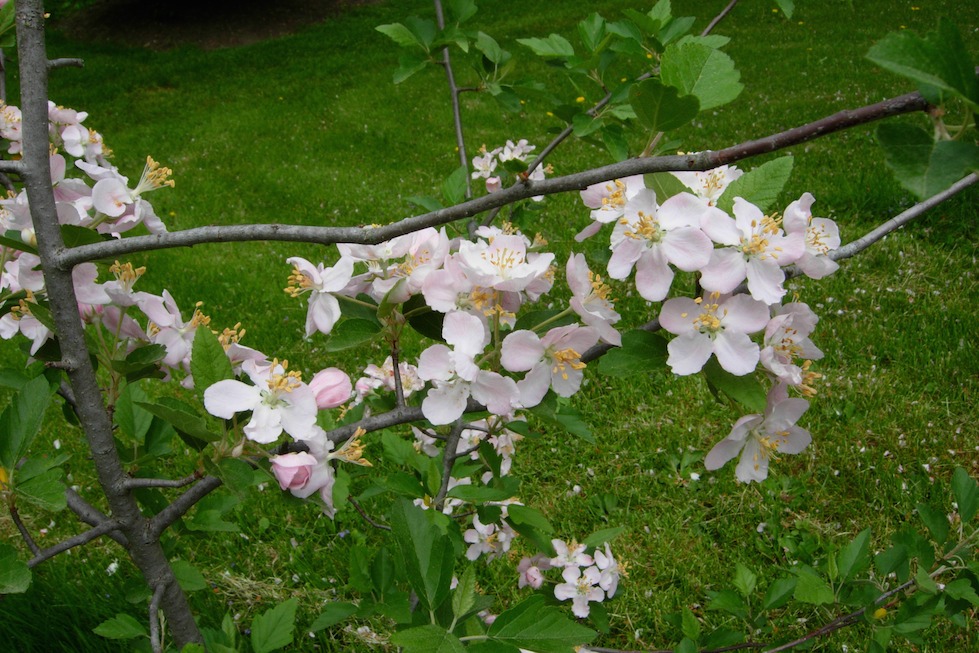Saving living space for living
things one yard at a time
Cultivars
Cultivars are plants that are “cultivated varieties.” They are created in three ways:
- Natural selection may occur in nature or in a greenhouse. A single plant may be different from the rest of its species in appearance or behavior. It is as if all your brothers and sisters are blond until one is born with dark hair. Someone notices that a plant is different and propagates it to retain the difference.
- Hybridization occurs when a horticulturist breeds two different species or varieties to each other and then propagates the offspring. Most hybrids are created in nurseries.
- Genetic engineering occurs when scientists directly manipulate plant DNA to produce a particular trait. Expense usually limits use of the technique to non-native plants.

Native Crabapple

Native Crabapple
Horticulturists generally produce cultivars by cloning; about 70% of cultivars are clones. These specially named plants have identical DNA and are grown from cuttings, by division or by tissue culture. Because the clones are identical, a serious loss of genetic diversity accompanies their use. This is important because diversity protects a species from calamity due to disease, pests, drought or other natural phenomena.
One can recognize a cultivar because its name involves more than the two-word Latin name of the native species. Take a reference like the CFC Plant Sale form to the nursery with you when you buy plants; it provides the binomial Latin names for many native species. One can identify a cultivar by noting an additional name written capitalized, unitalicized, and in single quotation marks. The native great white trillium may become the cultivar Trillium grandiflorum ‘Rosalie,’ two words in Latin for genus and species; one word in English indicates the created cultivar.
A particular cultivar may be grown for its unusual flower color or form, leaf color, size, growth rate, or disease resistance. We may recognize the appearance of that cultivar, but we can’t necessarily identify all the losses that accompany its creation. Can the bees still use it? Does it have nectar? Is it still drought resistant? Can the larvae of Lepidoptera use the leaves as nourishment? Too often there is a serious loss that we cannot identify even though we recognize the appearance of the cultivar.
Another problem is gender. Too often trees and shrubs are bred to be all males so that they don’t produce fruit to drop on the driveway or patio. Alternatively, a cultivar like that for Ilex glabra, inkberry, is only female, but there still won’t be fruit without an available male.
Cultivars often fail to perform the same ecological role as the true native species. Echinacea cultivars have been manipulated to provide strange colors and shapes. They may be sterile, providing no seed for the finches. They are sometimes double, providing no accessible pollen and nectar for pollinators. One of the popular cultivars of our native shrub Physocarpus, ninebark, no longer serves as a host for the specialist native ninebark beetle because its leaf chemistry has changed.
Finally, many cultivars are bred to be “pest-free.” This is one of the greatest drawbacks to using cultivars. Those insect pests provide food for birds, amphibians and other native wildlife. Learn to love the holes and knobs and imperfections on the leaves and stems of your native plants. They indicate that your yard provides for toads and nestlings. Our native insects do not eradicate their food supply by harming the plant species on which they feed. The plants and insects evolved together, and they need each other. It is the alien insects like Japanese beetles and emerald ash borers that destroy plants.
Please plant native species not cultivars, and watch for the bumblebees and catbirds and chickadees that use the truly native plants in your yard.
